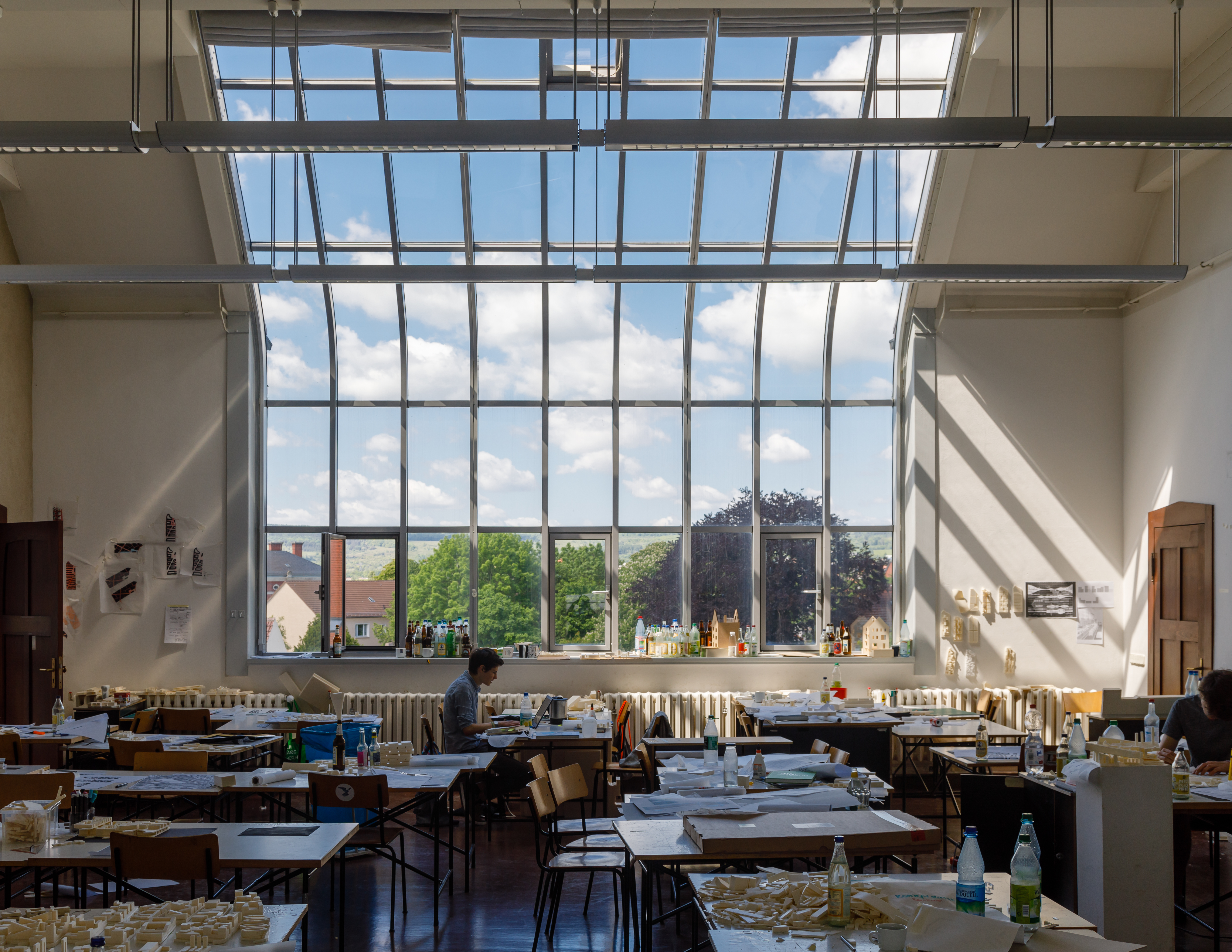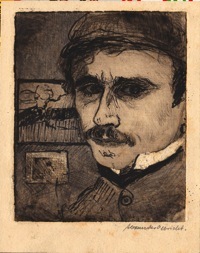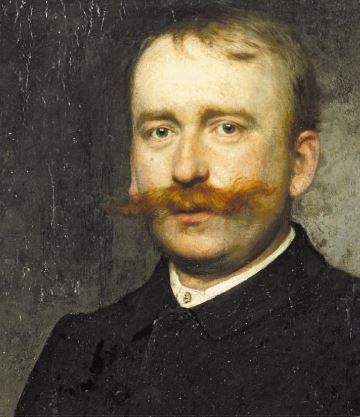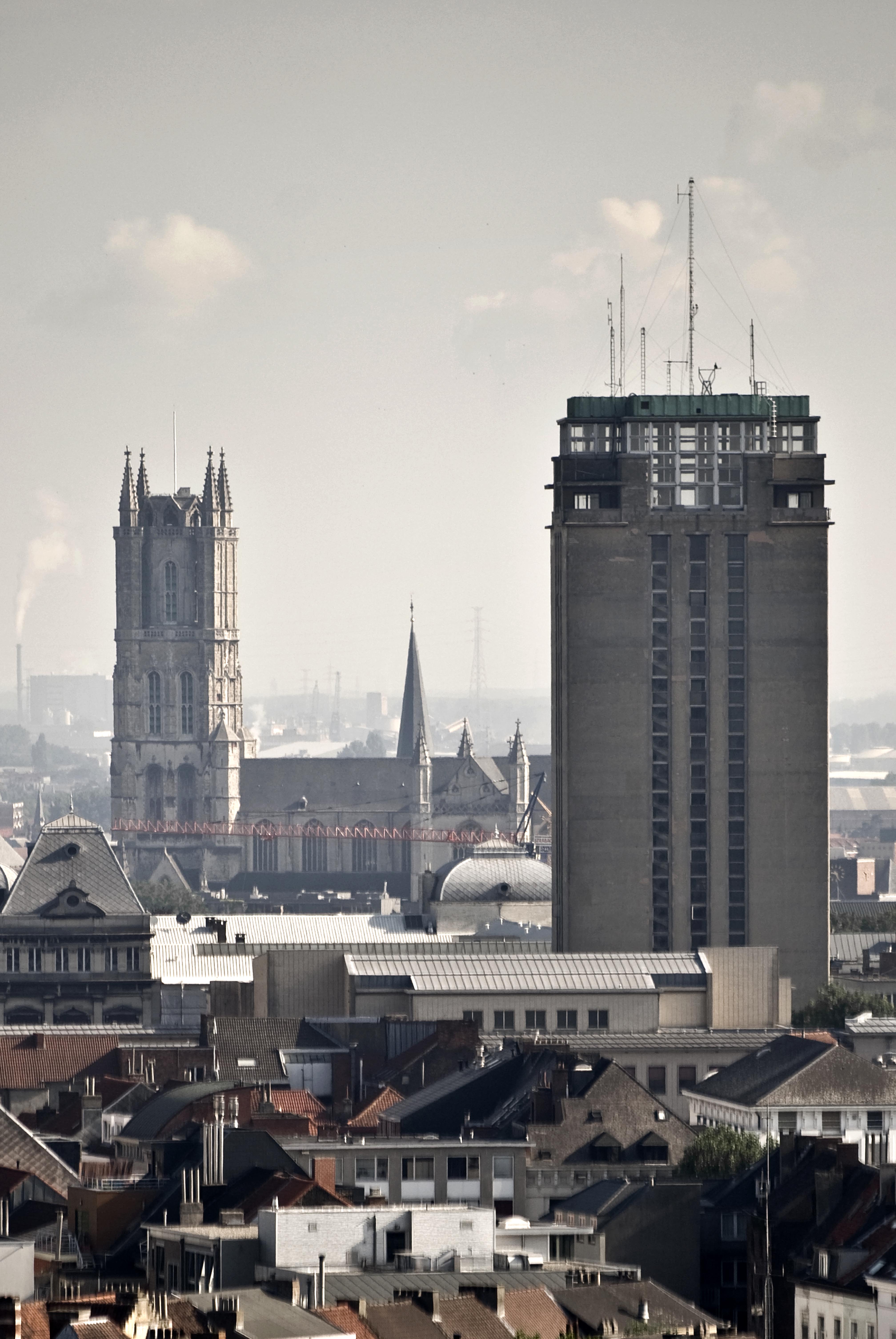|
Bauhaus University, Weimar
The Bauhaus-Universität Weimar is a university located in Weimar, Germany, and specializes in the artistic and technical fields. Established in 1860 as the Great Ducal Saxon Art School, it gained collegiate status on 3 June 1910. In 1919 the school was renamed Bauhaus by its new director Walter Gropius and it received its present name in 1996. There are more than 4000 students enrolled, with the percentage of international students above the national average at around 27%. In 2010 the Bauhaus-Universität Weimar commemorated its 150th anniversary as an art school and college in Weimar. In 2019 the university celebrated the centenary of the founding of the Bauhaus, together with partners all over the world. Academic tradition in Weimar Weimar boasts a long tradition of art education and instruction in the areas of fine art, handicrafts, music and architecture. In 1776 the Weimar Princely Free Zeichenschule was established, but gradually lost significance after the Grand Du ... [...More Info...] [...Related Items...] OR: [Wikipedia] [Google] [Baidu] |
Weimar
Weimar is a city in the state of Thuringia, Germany. It is located in Central Germany between Erfurt in the west and Jena in the east, approximately southwest of Leipzig, north of Nuremberg and west of Dresden. Together with the neighbouring cities of Erfurt and Jena, it forms the central metropolitan area of Thuringia, with approximately 500,000 inhabitants. The city itself has a population of 65,000. Weimar is well known because of its large cultural heritage and its importance in German history. The city was a focal point of the German Enlightenment and home of the leading figures of the literary genre of Weimar Classicism, writers Johann Wolfgang von Goethe and Friedrich Schiller. In the 19th century, noted composers such as Franz Liszt made Weimar a music centre. Later, artists and architects such as Henry van de Velde, Wassily Kandinsky, Paul Klee, Lyonel Feininger, and Walter Gropius came to the city and founded the Bauhaus movement, the most important German de ... [...More Info...] [...Related Items...] OR: [Wikipedia] [Google] [Baidu] |
Theodor Hagen (artist)
Theodor Joseph Hagen (24 May 1842, Düsseldorf – 12 February 1919, Weimar) was a German painter and art teacher. Life He was born into an old, established Rhenish merchant family. From 1863 to 1868, he studied with Oswald Achenbach at the Kunstakademie Düsseldorf. In 1871, he was summoned to the Weimar Saxon-Grand Ducal Art School to teach landscape painting as a replacement for Max Schmidt, who had left to take another position. Three years later, he received a permanent appointment. He was head of the art department from 1876 to 1881, but grew tired of his administrative duties and returned to teaching. His best-known students were Christian Rohlfs, Hanns Diehl, and Franz Bunke. He was one of the founders of German Impressionism. After trying out several styles during his early years, he became attracted to the plein-air painting of the French Barbizon School. Through his friendship with Alfred Lichtwark, the first Director of the Kunsthalle Hamburg, he spent some tim ... [...More Info...] [...Related Items...] OR: [Wikipedia] [Google] [Baidu] |
Bauhaus And Its Sites In Weimar, Dessau And Bernau
Bauhaus and its Sites in Weimar, Dessau and Bernau is a World Heritage Site in Germany, comprising six separate sites which are associated with the Bauhaus art school. It was designated in 1996 with four initial sites, and in 2017 two further sites were added. The Bauhaus was only in operation from 1919 until 1933 and it educated no more than 1,250 students, of whom only 155 actually graduated with a Bauhaus Diploma.Arts in Exil. Objects. Konrad Püschel:List of Names Retrieved 24 April 2019Knorr, Susan; Kern, Ingolf; Welzbacher, Christian (2012) ''Bauhaus Reisebuch'', Bonn: Dumont Nevertheless, the school revolutionized 20th century architectural and aesthetic thinking and practice. " [...More Info...] [...Related Items...] OR: [Wikipedia] [Google] [Baidu] |
World Heritage Site
A World Heritage Site is a landmark or area with legal protection by an international convention administered by the United Nations Educational, Scientific and Cultural Organization (UNESCO). World Heritage Sites are designated by UNESCO for having cultural, historical, scientific or other form of significance. The sites are judged to contain " cultural and natural heritage around the world considered to be of outstanding value to humanity". To be selected, a World Heritage Site must be a somehow unique landmark which is geographically and historically identifiable and has special cultural or physical significance. For example, World Heritage Sites might be ancient ruins or historical structures, buildings, cities, deserts, forests, islands, lakes, monuments, mountains, or wilderness areas. A World Heritage Site may signify a remarkable accomplishment of humanity, and serve as evidence of our intellectual history on the planet, or it might be a place of great natural beauty. A ... [...More Info...] [...Related Items...] OR: [Wikipedia] [Google] [Baidu] |
Alexander Olbricht
Alexander Gustav Georg Olbricht (6 June 1876, Breslau - 11 November 1942, Weimar) was a German artist. He created approximately 2,000 graphics, engravings, silhouettes and oil paintings. Biography His father, Gustav Olbricht (1851–1892) was a painter and art restorer at the Silesian Museum of Fine Arts. At the age of sixteen, he was employed by the firm of "P. Strunk", an art material supplier. After his father's death, he enrolled at the , where he studied with the landscape painter, . In 1899, he transferred to the Grand-Ducal Saxon Art School, Weimar, and studied with Theodor Hagen (artist), Theodor Hagen. Five years later, he married Margarethe Thurow (1882–1972), from Mecklenburg, whom he had met at the school. After this, he gradually gave up oil painting in favor of graphics and printmaking. In 1908, he produced his first large format etchings and, the following year, produced a series of twenty small format etchings depicting Weimar and its surroundings. He was draf ... [...More Info...] [...Related Items...] OR: [Wikipedia] [Google] [Baidu] |
Walther Klemm
Walther Klemm (June 18, 1883 – August 11, 1957) was a German painter, printmaker, and illustrator. He was born in Karlsbad and studied at the University of Applied Arts Vienna and the University of Vienna. In 1904 he exhibited with the Vienna Secession and moved to Prague and established a studio with Carl Thiemann. Klemm and Thiemann moved to the Dachau art colony in 1908 and both joined the Berlin Secession and Deutscher Künstlerbund around 1910. Klemm was appointed professor of graphics at the Weimar Saxon Grand Ducal Art School in 1913 and after the Second World War aided in the reconstruction of the Weimar Art School. In 1952 he was named an honorary senator of the Weimar School of Architecture and Civil and Structural Engineering (now absorbed by the Bauhaus University, Weimar The Bauhaus-Universität Weimar is a university located in Weimar, Germany, and specializes in the artistic and technical fields. Established in 1860 as the Great Ducal Saxon Art Scho ... [...More Info...] [...Related Items...] OR: [Wikipedia] [Google] [Baidu] |
Max Thedy
Max Thedy (16 October 1858, Munich - 13 August 1924, PollingPeter Stapf: ''Der Maler Max Thedy (1858–1924). Leben und Werk''. Böhlau, Cologne 2014.) was a German painter, designer and engraver. He is sometimes erroneously referred to as Marc Thedy. Biography He was the youngest of twelve children born to Johann Valentin Thedy, a ''Verwaltungsaktuar'' (administrative assistant in the community government) and his wife, Theresia. After his parents' premature deaths, he was taken in by the family of the Hamburg painter, Georg Friedrich Louis Reinhardt (1819–1905) and encouraged to pursue a career in art. in the Matrikelbuch 1841–1884 of the Academy of Fine Arts, Munich. After 1875, he was a student at the |
Bauhaus Logo
The Staatliches Bauhaus (), commonly known as the Bauhaus (), was a German art school operational from 1919 to 1933 that combined crafts and the fine arts.Oxford Dictionary of Art and Artists (Oxford: Oxford University Press, 4th edn., 2009), , pp. 64–66 The school became famous for its approach to design, which attempted to unify individual artistic vision with the principles of mass production and emphasis on function. The Bauhaus was founded by architect Walter Gropius in Weimar. It was grounded in the idea of creating a Gesamtkunstwerk ("comprehensive artwork") in which all the arts would eventually be brought together. The Bauhaus style later became one of the most influential currents in modern design, modernist architecture, and architectural education. The Bauhaus movement had a profound influence upon subsequent developments in art, architecture, graphic design, interior design, industrial design, and typography. Staff at the Bauhaus included prominent artists suc ... [...More Info...] [...Related Items...] OR: [Wikipedia] [Google] [Baidu] |
Henry Van De Velde
Henry Clemens van de Velde (; 3 April 1863 – 15 October 1957) was a Belgian painter, architect, interior designer, and art theorist. Together with Victor Horta and Paul Hankar, he is considered one of the founders of Art Nouveau in Belgium.'''' He worked in Paris with Samuel Bing, the founder of the first gallery of Art Nouveau in Paris. Van de Velde spent the most important part of his career in Germany and became a major figure in the German Jugendstil. He had a decisive influence on German architecture and design at the beginning of the 20th century. Early life Van de Velde was born in Antwerp, where he studied painting under Charles Verlat at the famous Royal Academy of Fine Arts, Antwerp. He then went on to study with the painter Carolus-Duran in Paris. As a young painter he was strongly influenced by Paul Signac and Georges Seurat and soon adopted a neo-impressionist style, and pointillism. In 1889 he became a member of the Brussels-based artist group "Les XX". After ... [...More Info...] [...Related Items...] OR: [Wikipedia] [Google] [Baidu] |
Gottlieb Elster
Gottlieb Elster (8October 18676December 1917) was a German sculptor. Life Elster was born in Kreiensen on 8 October 1867. He studied at the Braunschweig University of Technology from 1888 to 1891, later attending the Academy of Fine Arts, Munich. He then went to Berlin, where he studied under Otto Lessing, Fritz Schaper and, until 1905, worked with Adolf Brütt. He maintained a private studio during most of these years. In 1910, he became Brütt's successor as Director of the Weimar Sculpture School and their foundry. He returned to Braunschweig in 1913 and remained there until his death. Selected major works * 1903: Statue of Frederick the Great in his youth at the Marketplace in Rheinsberg. (placed in storage by the East German government in 1950; reinstalled in 1995) [...More Info...] [...Related Items...] OR: [Wikipedia] [Google] [Baidu] |
Adolf Brütt
Adolf Brütt (10 May 1855 in Husum – 6 November 1939 in Bad Berka)Husum Tourismus: Brief Biography of Brütt was a German sculptor. He was the founder of the Weimarer Bildhauerschule (Weimar Sculpture School) and its accompanying bronze . Biography Brütt originally trained in as a and worked on several projects, including |
Fritz Mackensen
Fritz Mackensen (born 8 April 1866 in Greene, near Kreiensen, Duchy of Brunswick – 12 May 1953 in Bremen) was a German painter of the Düsseldorf school of painting and Art Nouveau. He was a friend of Otto Modersohn and Hans am Ende, and was one of the co-founders of the artists' colony at Worpswede. From 1933 to 1935 he was head of the ''Nordische Kunsthochschule'' in Bremen (today's University of the Arts Bremen). In 1937 he became a member of the Nazi Party. He was buried in the Worpswede Cemetery. Selected works ;paintings *"Gottesdienst im Freien", Lower Saxony State Museum in Hanover *"Tierbild", State Museum for Art and Cultural History in Oldenburg in Oldenburg *"Die Scholle", museum Weimar ;bronze sculpture *"Alte Frau mit Ziege", Kunsthalle Bremen The Kunsthalle Bremen is an art museum in Bremen, Germany. It is located close to the Bremen Old Town on the "Culture Mile" (german: Kulturmeile). The Kunsthalle was built in 1849, enlarged in 1902 by architect Ed ... [...More Info...] [...Related Items...] OR: [Wikipedia] [Google] [Baidu] |






